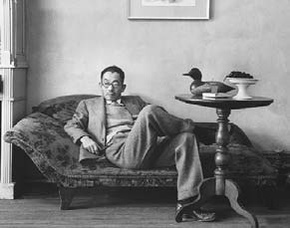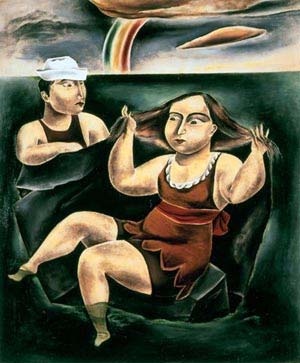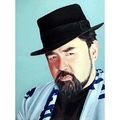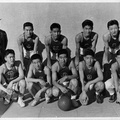While there are Asian American artists who have received notable acclaim and recognition, very few have been the subject of a photo portrait, and perhaps only Yasuo Kuniyoshi has been the subject of a photographer as well known as Arnold Newman. The portrait, from 1941, reveals a dapper, equanimous looking man, seated on a divan. It is not a jarring image, but one that centers Kuniyoshi in a very American looking environment.
Nonetheless, Kuniyoshi, who came to Seattle in 1906 from Okayama, Japan, was never able to become an American citizen. He left Seattle for Los Angeles, where he attended public schools and began to study art. In 1910 he moved to New York, hoping to find a life aside from picking fruit and cleaning hotel rooms.
In New York he attended the Art Students League, coming under the influence of Kenneth Hayes Miller. Miller introduced Kuniyoshi to many European, ‘Old Masters’, but also encouraged him to find his own style. After moving to Maine, Kuniyoshi traveled to Europe to study painting in 1925, and after returning, located in Woodstock, NY, where he assisted in founding the Woodstock School. In 1935 he was awarded a Guggenheim Fellowship.
His early work reveals an obsession with female nudes. The subjects are often posed in a relaxed, seductive manner, their torsos flattened and trapezoidal. While his work was often well received, he did not escape racial comments questioning his status as an “American” painter. His first attempt to become a citizen was crushed by the Pearl Harbor attack, and though he was not interned, he found the WWII years quite difficult. Despite this, he did considerable work for the war effort—producing propaganda drawings which showed the viciousness of the Japanese military—and his subject matter began to change and become more political and jarring. Paintings like Rotting On The Shore, Little Girl Run For Your Life and Headless Horse Who Wants To Jump, are considerably different from his nudes of the 1930’s, and they reflect a haunted sensibility that is in the grasp of both fear and the unknown.
After the war, Kuniyoshi’s work was selected by the Whitney Museum of New York for their first one man retrospective, a significant achievement and recognition, especially considering how embattling the mid-1940’s had been for him. He also never took his eye off of his desire to become an American citizen, as he re-applied during the early 1950’s. His application was in the process of being completed, and possibly approved when he died in 1953, at the age of 60.
Although he is easily remembered for his numerous nudes, Kuniyoshi’s best work is what he produced from the late 1930’s until his death. There is a sustained sense of loss, misfortune, fear, and disillusionment in many of his best works, and the unusual blend of line, color, flatness and almost cubistdimensionality give his paintings stark and unlikely visual effects, which draw in both European and Japanese techniques. We can all benefit from this courage, vision and commitment.
* This article was originally published in the JACLER, JACL Chicago Chapter Newsletter (January/February 2007).
© 2007 Paul Yamada






